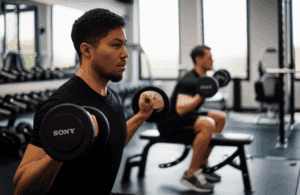Are you truly strong? Strength isn’t just about lifting heavy weights; it’s about control, endurance, and moving your body efficiently. This 6-minute bodyweight test challenges your strength, stamina, and mental fortitude using nothing but your own body as resistance. If you can push through this workout with solid form, you’re tougher than you think.
Why Bodyweight? The Power of You
Bodyweight exercises are functional, accessible, and incredibly effective.
- Functional Strength: Bodyweight movements mimic real-life activities, improving your ability to perform everyday tasks with ease.
- Accessibility: No gym? No problem! Bodyweight workouts can be done anywhere, anytime, making them perfect for busy schedules or travel.
- Versatility: Bodyweight exercises can be modified to suit any fitness level, from beginner to advanced.
- Mind-Body Connection: These workouts force you to be aware of your body in space, enhancing coordination and balance.
- Improved Endurance: Bodyweight circuits elevate your heart rate, boosting cardiovascular endurance alongside muscular strength.
The 6-Minute Bodyweight Challenge
This isn’t about mindlessly rushing through reps. The goal is to maintain perfect form throughout the entire 6 minutes. Break only when you need to recover or correct your technique.
The Circuit:
Perform the following exercises back-to-back with minimal rest:
- Walkout to Push-Up: A dynamic movement that combines core work with upper body strength.
- Alternating Dumbbell Lunge with Reach: Strengthens the lower body and trains core control through a rotational movement.
- Dumbbell Deadlift into Bent-Over Row: Works the posterior chain (back, glutes, hamstrings) and improves posture.
- Alternating Lateral Lunge with Bicep Curl: Challenges lateral movement while incorporating an upper body component.
Important Considerations:
- Warm-up: Prepare your body with light cardio and dynamic stretches before starting the test.
- Form Focus: Prioritize quality over quantity. If your form breaks down, take a short rest before continuing.
- Listen to Your Body: Don’t push through pain. Modify exercises as needed to maintain proper form and avoid injury.
- Cool-down: After the test, perform static stretches to improve flexibility and reduce muscle soreness.
Exercise Breakdown: Mastering the Moves
Let’s dive into each exercise with detailed instructions:
1. Walkout to Push-Up
- Starting Position: Stand tall with your feet hip-distance apart.
- Hinge and Walkout: Hinge at your hips and walk your hands forward, maintaining a straight back, until you reach a high plank position.
- Push-Up: Perform a push-up, lowering your chest towards the floor while keeping your elbows at a 45-degree angle. Engage your core and maintain a straight line from head to heels.
- Return: Push back up to the high plank position and walk your hands back towards your feet.
- Stand Up: Stand up, returning to the starting position.
- Repetitions: Continue for the duration of the test, focusing on smooth, controlled movements.
Modifications:
- On Knees: Perform the push-up on your knees to reduce the intensity.
- Incline Push-Up: Do the push-up with your hands elevated on a bench or box to make it easier.
2. Alternating Dumbbell Lunge with Reach
- Starting Position: Hold a dumbbell in one hand. Stand with feet hip-width apart.
- Lunge and Reach: Step the opposite foot forward into a lunge. As you lower, reach the dumbbell down towards your front ankle, keeping a tall chest and engaging your shoulder blades.
- Return: Push back to the starting position, maintaining control.
- Switch Sides: Repeat on the opposite side.
Modifications:
- No Dumbbell: Perform the lunge without a dumbbell.
- Limited Range of Motion: Reduce the depth of the lunge to ease the intensity.
3. Dumbbell Deadlift into Bent-Over Row
- Starting Position: Stand tall with your feet hip-width apart, holding a dumbbell in each hand.
- Deadlift: Hinge at your hips, sending your weight back into your heels while maintaining a flat back. Lower the dumbbells down the front of your legs.
- Bent-Over Row: Once you reach the bottom of the deadlift, row the weights up to your torso, squeezing your shoulder blades together.
- Lower and Return: Control the dumbbells as you lower them back down. Drive through your heels to return to the standing position.
Modifications:
- Romanian Deadlift: Perform a Romanian deadlift, focusing on the hamstring stretch and minimizing the knee bend.
- Reduce Weight: Use lighter dumbbells or resistance bands.
4. Alternating Lateral Lunge with Bicep Curl
- Starting Position: Hold a dumbbell in each hand.
- Lateral Lunge: Step one leg out to the side into a lateral lunge, pressing your hips back as your lead leg bends. Keep your opposite leg straight and maintain a tall chest.
- Bicep Curl: As you push back to standing, perform a controlled bicep curl with both arms, keeping your elbows close to your sides.
- Switch Sides: Repeat on the other side.
Modifications:
- No Dumbbells: Perform the lateral lunge without dumbbells.
- Reduce Range of Motion: Limit the depth of the lateral lunge to decrease the difficulty.
Beyond the Test: Bodyweight Training for Life
This 6-minute challenge is just a glimpse of the potential of bodyweight training. Incorporate bodyweight exercises into your regular routine to:
- Build Strength and Muscle: Push-ups, squats, lunges, and planks are excellent for building muscle mass and overall strength.
- Improve Cardiovascular Fitness: Bodyweight circuits can elevate your heart rate and improve your endurance.
- Enhance Flexibility and Mobility: Bodyweight movements can improve your range of motion and flexibility.
- Boost Metabolism: Bodyweight exercises engage multiple muscle groups, leading to increased calorie burn and a higher metabolic rate.
- Prevent Injuries: Bodyweight training strengthens stabilizing muscles and improves body awareness, reducing the risk of injuries.
Setting Your Bodyweight Standards
While the 6-minute test is a great snapshot of your fitness, establishing longer-term bodyweight strength goals can be motivating. Here are some general benchmarks to strive for:
- Push-Ups: Aim for at least 20-30 consecutive push-ups with proper form.
- Pull-Ups: Work towards performing 5-10 pull-ups with a full range of motion.
- Squats: Strive for 20-30 bodyweight squats with good form and full depth.
- Plank: Hold a plank for at least 60 seconds, maintaining a straight line from head to heels.
- Lunge: Perform 10-15 lunges per leg, maintaining proper form.
Are You Stronger Than You Think?
This 6-minute bodyweight test is more than just a workout; it’s a gauge of your overall fitness, control, and mental toughness. Embrace the challenge, focus on your form, and listen to your body. You might be surprised at just how strong you truly are. Bodyweight training is a journey, not a destination. Keep pushing your limits and discover the incredible potential of your own body.







